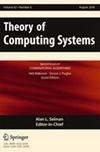论三变量word方程的解集
IF 0.4
4区 计算机科学
Q4 COMPUTER SCIENCE, THEORY & METHODS
引用次数: 0
摘要
众所周知,任何无常数三变量字方程的解集都可以用参数词来表示,而这些参数词中的数字参数数量和嵌套程度与方程长度的关系至多是对数。我们证明,对于不平衡方程,即至少有一个变量在左侧和右侧出现的次数不同的方程,这一结果可以得到显著改善。更具体地说,在这种情况下,只要有两个数值参数和一级嵌套就足够了。我们还讨论了未来证明平衡方程类似结果的可能性。本文章由计算机程序翻译,如有差异,请以英文原文为准。
On the Solution Sets of Three-Variable Word Equations
It is known that the set of solutions of any constant-free three-variable word equation can be represented using parametric words, and the number of numerical parameters and the level of nesting in these parametric words is at most logarithmic with respect to the length of the equation. We show that this result can be significantly improved in the case of unbalanced equations, that is, equations where at least one variable has a different number of occurrences on the left-hand side and on the right-hand side. More specifically, it is sufficient to have two numerical parameters and one level of nesting in this case. We also discuss the possibility of proving a similar result for balanced equations in the future.
求助全文
通过发布文献求助,成功后即可免费获取论文全文。
去求助
来源期刊

Theory of Computing Systems
工程技术-计算机:理论方法
CiteScore
1.90
自引率
0.00%
发文量
36
审稿时长
6-12 weeks
期刊介绍:
TOCS is devoted to publishing original research from all areas of theoretical computer science, ranging from foundational areas such as computational complexity, to fundamental areas such as algorithms and data structures, to focused areas such as parallel and distributed algorithms and architectures.
 求助内容:
求助内容: 应助结果提醒方式:
应助结果提醒方式:


